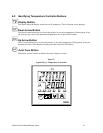Cabinet Series Dehumidifying Dryer 14
3-5 Process Air Connections Between the Dryer and Drying Hopper
; Remove the cap plugs from the inlet, discharge and bleed tubes before operation.
; Use high-temperature flexible dryer hose to connect the dryer to the drying hopper.
; Keep the delivery hose as short as possible to minimize heat loss. Insulated dryer hose is
available for maximum energy savings.
; Do not shorten the return hose.
; Make sure the hoses are not kinked.
; Drying hopper air inlet and outlet locations vary from one drying hopper model to
another, but always connect the hoses so the dry process air from the dryer enters the
bottom of the drying hopper and flows out the top to return to the dryer inlet.
3-6 Connecting Cooling Water to the Optional Aftercooler
High temperature applications (300°F to 400°F / 148°C to 204°C) require aftercoolers to cool
moist air returning to the dryer from the drying hopper. An aftercooler cools the return air by
100°F (38°C); this maintains dryer efficiency and condenses unwanted plasticizers from the
airstream. Aftercoolers are also required in extremely low temperature applications.
Installing Water Lines
• Use the ½” (about 13 mm) brass pipe nipples for water line connections. Inlet
and outlet line positions do not matter.
• Make sure you grip the nipple tightly when attaching a fitting. Doing so prevents
damage to the soft copper coils. You should make connections with flexible hose
to allow removing the coil assembly for cleaning.
• The aftercooler is designed to utilize either tower or city water as warm as 85ºF
(29ºC). Recommended flow rate is one to three (1 to 3) gallons per minute (4 to
11 liters per minute).
3-7 Drying Hopper
Removing the Rust Inhibitor
Rust preventative has been applied to internal unfinished surfaces. Remove rust inhibitor before
using the drying hopper.
Using a non-water based degreasing agent, clean all inside surfaces of the drying hopper. Allow
components to dry thoroughly.
Inspect the inside of the drying hopper for loose connections, foreign objects, or a blocked
diffuser.
Air Trap Considerations
The air trap assembly in the top of the drying hopper prevents ambient air from contaminating the
material being dried.
; Keep the material level at the mid point of the air trap for maximum efficiency.
; Use a hopper loader or vacuum conveying system to maintain the proper material level.


















